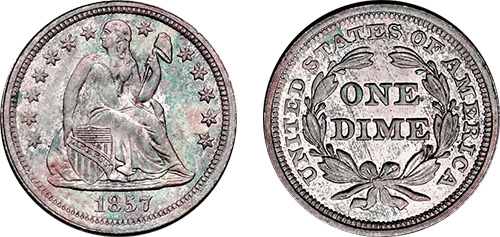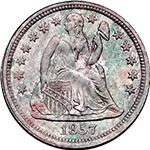In addition to the introduction of the Seated Liberty dime in 1837, the US Mint also struck a Seated Liberty half dime, which circulated from 1837 to 1873 and was slightly smaller than the Seated Liberty dime. Both the Seated Liberty half dime and the Seated Liberty dime look and feel similar, so it is important to check the face value on the reverse. The reason that dimes and half dimes were so small is that the U.S. Mint needed to adjust the respective silver content of these coins to the silver content of a silver dollar. For example, a Seated Liberty dollar weighs 26.73 grams, and a Seated Liberty dime weighs about 2.67 grams or about a tenth of a silver dollar. In contrast, U.S. coins with lower denominations were made out of base metals. Nowadays, the dime is still the smallest size of coins in circulation.

The early 19th century marked an era of remarkable imperial expansion for the U.S., which was also reflected in its new coinage. President Andrew Jackson appointed Robert Maskell Patterson as Mint Director who was a great admirer of the seated figure of Britannia featured on English coins. Trying to echo the country’s new imperialism, he instructed Chief Engraver William Kneass to draw a similar image with Liberty. After Kneass fell ill, Christian Gobrecht completed the design for the silver dollar, which was first struck in 1836. The first year, the obverse side did not feature the 13 stars. Collectors covet the “No Stars Obverse” issue due to its outstanding visual appeal created by the blank parts highlighting the Seated Liberty.
It was the U.S. Mint’s goal with the Seated Liberty was to produce consistent coinage that would prevent counterfeiting and allow for quality control. The reverse side posed a true technological innovation: For the first time ever, a working die was sunk without any design elements having to be added my hand. As a result, the new coins were so uniform that it was difficult to counterfeit them. The Seated Liberty dime circulated widely throughout the first half of the 19th century. However, the U.S. Civil War in the 1860’s and a silver surplus in the 1870’s slowed down production, so some dates and mintmarks are rare and valuable. While the original design remained the same, the coin did undergo some modifications throughout the years.
The original obverse design of the Seated Liberty dime features Lady Liberty sitting on a rock. She holds a pole with a liberty cap in one hand and rests her other hand upon a shield with LIBERTY stamped across it. The other essential feature that never changed on the obverse side is the date stamped below the rock. The original reverse of the Seated Liberty dime has a wreath circling the denomination ONE DIME. Furthermore, the reverse displayed the inscription UNITED STATES OF AMERICA around the wreath.
The Seated Liberty dimes consist of 90% silver and 10% copper.
Seated Liberty Dime
| Diameter | 17.9 mm |
| Metal | 90% silver and 10% copper |
| Weight | 2.49 to 2.67 grams |
| Face value | One dime (10 cents) |
The design of the Seated Liberty dime changed throughout the years. From 1838 until 1860, 13 stars circle the top of the front (“Stars Obverse”), but they were replaced by the legend UNITED STATES OF AMERICA in 1860. The “Legend Obverse” coin is one of the most popular 19th century US coins. From 1840 to 1853, Lady Liberty’s resting arm was draped, but for other years, her arm was bare. Arrows at either side of the date were added in 1853 (until 1855) to mark dimes whose silver content had been reduced due to drastically falling gold prices. The arrows were included again in 1873, when the Mint Act marginally increased the weight of the silver dime. As the legend UNITED STATES OF AMERICA moves to the obverse in 1860, the wreath on the reverse was enlarged and began to incorporate images of grain.
The mintmark might either be just above or just below the bottom of the wreath. The mintmarks are S, O, and CC for San Francisco, New Orleans, and Carson City, respectively. No mintmark means that the coin came from Philadelphia, the largest U.S. Mint facility. The weight of the coin also changed over the years because of design changes. From 1837 to 1853, the weight was 2.57 grams, from 1853 to 1873, it was 2.49 grams, and it was 2.5 grams after than until the end of production. In 1872, legislation mandated the standard of 2.5 grams for future coin production.
The number of design changes makes this coin very interesting for collectors and investors alike. Even though the U.S. Mint produced a lot of Seated Liberty dimes during most years, production was low during the 1860s. Also, Carson City dimes from the 1870s are rare, especially the unique 1873-CC No Arrows Dime, the only remaining coin from the original mintage of 12,400 coins before the change of weight was authorized. The many different designs make collecting the complete series of Seated Liberty dimes challenging, but scoring a rare issue can be an excellent investment.

